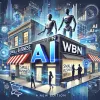
The cybersecurity landscape is evolving rapidly, and businesses across Canada face an increasing number of sophisticated cyber threats. From AI-driven attacks to deepfake scams, cybercriminals continue to exploit new technologies and vulnerabilities. Understanding these risks is crucial to safeguarding your operations, protecting sensitive data, and ensuring business continuity.
Expanding Cyber Risks in Remote Work Environments
With remote and hybrid work models now firmly established, businesses face heightened vulnerabilities. Employees often connect to company systems using personal devices and unsecured home networks, making them prime targets for cyberattacks. Human error remains one of the top causes of cloud security incidents, leading to potential breaches. Insecure connections, lack of visibility, and inconsistent security practices pose challenges in maintaining a secure remote work environment.
The Growing Threat of Supply Chain Attacks
Cybercriminals frequently target businesses through their third-party vendors, making supply chain attacks one of the most pressing cybersecurity risks. Smaller vendors often have weaker security measures, providing hackers with an easy entry point to larger corporate networks. This type of breach can lead to malware distribution through legitimate software updates or services, making it difficult for businesses to detect and mitigate these threats. Companies should conduct regular security assessments and vet vendors carefully to reduce exposure to such attacks.
AI-Driven Cyberattacks: A New Frontier for Hackers
Artificial intelligence (AI) and machine learning (ML) are increasingly being leveraged by cybercriminals to automate and enhance their attacks. In 2025, hackers are expected to use AI to scan networks for vulnerabilities, craft highly convincing phishing emails, and adapt attack strategies in real time to evade detection. Traditional security solutions that rely on recognizing known attack patterns are becoming less effective against AI-powered threats, leaving small and medium-sized businesses (SMBs) particularly vulnerable. To combat these attacks, businesses should invest in advanced cybersecurity tools that use AI for threat detection and response.
Deepfake Scams and Social Engineering: Exploiting Trust
Deepfake technology, which uses AI to create realistic videos and audio recordings, is becoming a major cybersecurity concern. Attackers can impersonate company executives or trusted contacts in phishing schemes, deceiving employees into transferring funds or revealing sensitive information. These attacks are particularly dangerous because they exploit the inherent trust within an organization. Employees should be trained to verify requests, even from seemingly legitimate sources, before taking action.
IoT-Based Cyber Threats: The Rising Risk of Connected Devices
As businesses increasingly rely on Internet-of-Things (IoT) devices for operations—such as surveillance systems, smart appliances, and environmental controls—cybercriminals see new opportunities to exploit vulnerabilities. Many IoT devices have minimal built-in security, making them susceptible to hacking. Attackers can use these devices to create botnets, launch distributed denial-of-service (DDoS) attacks, or gain unauthorized access to business networks. Companies must implement strict security measures, such as regularly updating IoT device firmware and restricting network access to only necessary devices.
Strengthening Your Cyber Defenses for 2025
As cyber threats continue to evolve, businesses must stay proactive in their cybersecurity strategies. To protect against these emerging risks, companies should prioritize:
- Employee Training – Educate staff about phishing scams, deepfake threats, and safe cybersecurity practices.
- Advanced Security Solutions – Invest in AI-powered detection tools to counter AI-driven attacks.
- Regular Security Assessments – Conduct frequent reviews to identify vulnerabilities within company networks and third-party vendors.
- Vendor Vetting – Assess the cybersecurity policies of supply chain partners to prevent breaches originating from external sources.
- IoT Security Best Practices – Secure all connected devices with strong passwords, regular updates, and access restrictions.
By implementing these measures, businesses can significantly reduce their risk exposure and stay ahead of cybercriminals in an increasingly digital world. In 2025, cybersecurity is not just an IT concern—it’s a business imperative.
_________________________________________________________Jenny is a business insurance broker with Waypoint Insurance. She can be reached at 604-317-6755 or jhansen@waypoint.ca. Connect with Jenny on LinkedIn at https://www.linkedin.com/in/jenny-holly-hansen-365b691b/. Connect with Jenny at BlueSky: https://bsky.app/profile/jennyhollyhansen.bsky.social
Jenny Holly Hansen is a cohost with Chris Sturges of the Langley Impact Networking Group. You are welcome to join us on Thursday’s from 4pm to 6pm at: Sidebar Bar and Grill: 100b - 20018 83A Avenue, Langley, BC V2Y 3R4
Tags: #Jenny Holly Hansen #Cyber Security #Cyber Threats #AI Driven Cyber Attacks #Deepfake Scams #Supply Chain Attacks #IoT Based Cyber Threats


